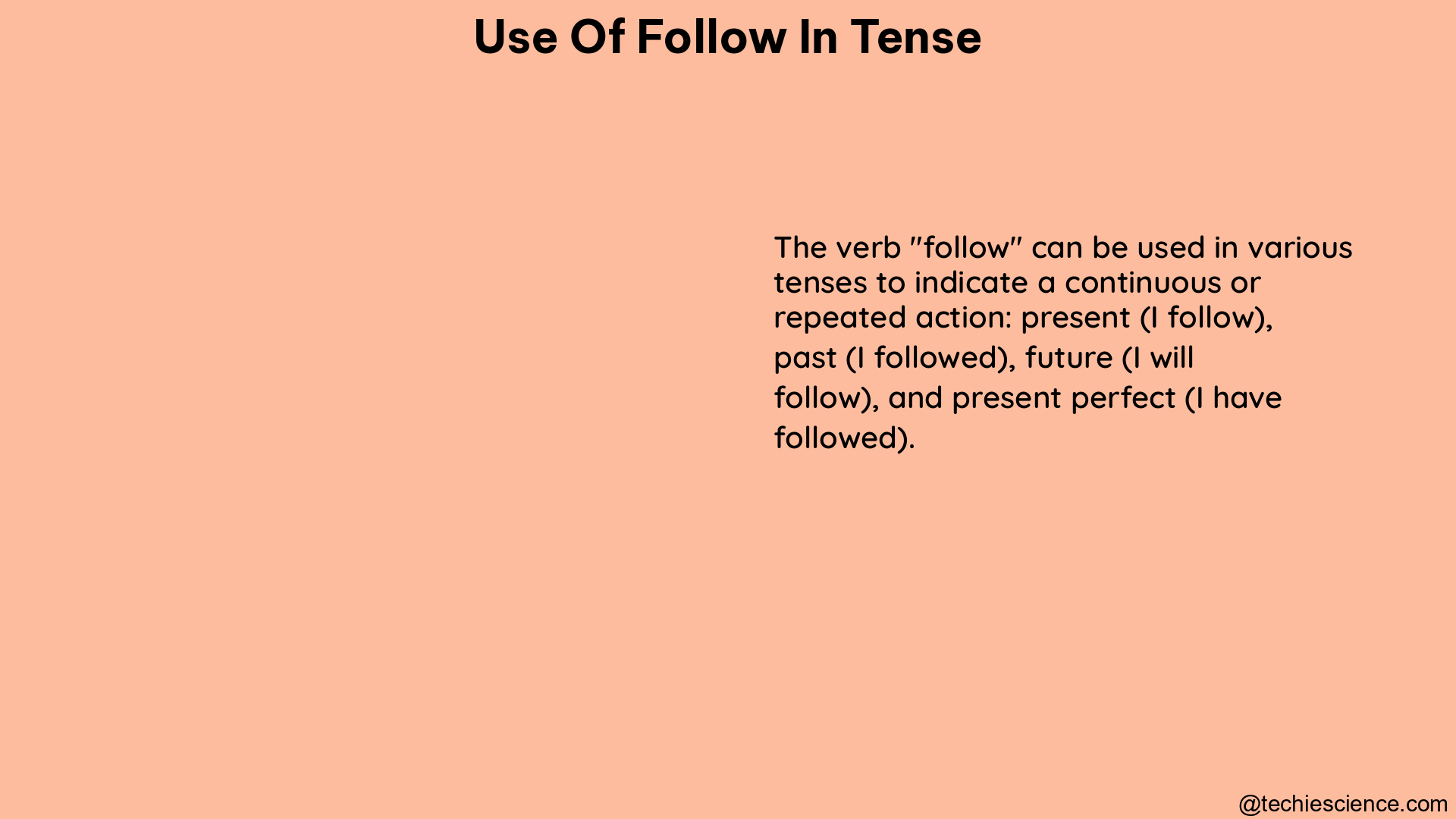The use of the verb “follow” in English grammar involves various tenses, conjugations, and specific grammatical rules. This comprehensive guide will provide you with a detailed understanding of how to use “follow” correctly in different tenses, along with examples to reinforce your learning.
Present Tense
Simple Present
In the simple present tense, the verb “follow” is conjugated as follows:
- I follow
- You follow
- He/She/It follows
- We follow
- You follow
- They follow
Example: “I follow the latest trends in technology.”
Present Progressive/Continuous
The present progressive/continuous tense is used to describe an ongoing action. The conjugation of “follow” in this tense is:
- I am following
- You are following
- He/She/It is following
- We are following
- You are following
- They are following
Example: “She is following the instructions carefully.”
Past Tense

Simple Past
The simple past tense is used to describe an action that occurred in the past. The conjugation of “follow” in this tense is:
- I followed
- You followed
- He/She/It followed
- We followed
- You followed
- They followed
Example: “I followed the directions and arrived at the destination on time.”
Past Progressive/Continuous
The past progressive/continuous tense is used to describe an ongoing action in the past. The conjugation of “follow” in this tense is:
- I was following
- You were following
- He/She/It was following
- We were following
- You were following
- They were following
Example: “They were following the news coverage of the event throughout the day.”
Past Perfect
The past perfect tense is used to describe an action that was completed before another past action. The conjugation of “follow” in this tense is:
- I had followed
- You had followed
- He/She/It had followed
- We had followed
- You had followed
- They had followed
Example: “By the time I arrived, they had followed the instructions and completed the task.”
Past Perfect Progressive/Continuous
The past perfect progressive/continuous tense is used to describe an ongoing action that was completed before another past action. The conjugation of “follow” in this tense is:
- I had been following
- You had been following
- He/She/It had been following
- We had been following
- You had been following
- They had been following
Example: “They had been following the project’s progress for several weeks before the final presentation.”
Future Tense
Simple Future
The simple future tense is used to describe an action that will occur in the future. The conjugation of “follow” in this tense is:
- I will follow
- You will follow
- He/She/It will follow
- We will follow
- You will follow
- They will follow
Example: “I will follow your advice and apply for the job.”
Future Progressive/Continuous
The future progressive/continuous tense is used to describe an ongoing action that will occur in the future. The conjugation of “follow” in this tense is:
- I will be following
- You will be following
- He/She/It will be following
- We will be following
- You will be following
- They will be following
Example: “Next week, I will be following the news coverage of the election.”
Future Perfect
The future perfect tense is used to describe an action that will be completed before another future action. The conjugation of “follow” in this tense is:
- I will have followed
- You will have followed
- He/She/It will have followed
- We will have followed
- You will have followed
- They will have followed
Example: “By the end of the month, I will have followed up with all the clients.”
Future Perfect Progressive/Continuous
The future perfect progressive/continuous tense is used to describe an ongoing action that will be completed before another future action. The conjugation of “follow” in this tense is:
- I will have been following
- You will have been following
- He/She/It will have been following
- We will have been following
- You will have been following
- They will have been following
Example: “By the time the project is due, we will have been following the progress for several weeks.”
Conditional
Simple Conditional
The simple conditional tense is used to describe an action that would occur under certain conditions. The conjugation of “follow” in this tense is:
- I would follow
- You would follow
- He/She/It would follow
- We would follow
- You would follow
- They would follow
Example: “If you gave me more information, I would follow up on the request.”
Conditional Progressive
The conditional progressive tense is used to describe an ongoing action that would occur under certain conditions. The conjugation of “follow” in this tense is:
- I would be following
- You would be following
- He/She/It would be following
- We would be following
- You would be following
- They would be following
Example: “If I had more time, I would be following the project’s progress more closely.”
Conditional Perfect
The conditional perfect tense is used to describe an action that would have been completed under certain conditions. The conjugation of “follow” in this tense is:
- I would have followed
- You would have followed
- He/She/It would have followed
- We would have followed
- You would have followed
- They would have followed
Example: “If I had received the instructions earlier, I would have followed them more carefully.”
Conditional Perfect Progressive
The conditional perfect progressive tense is used to describe an ongoing action that would have been completed under certain conditions. The conjugation of “follow” in this tense is:
- I would have been following
- You would have been following
- He/She/It would have been following
- We would have been following
- You would have been following
- They would have been following
Example: “If the project had started on time, we would have been following the progress for longer.”
Imperative
The imperative form of “follow” is used to give a direct command or instruction. The conjugation is:
- Follow
- Let’s follow
Example: “Follow the instructions carefully.” or “Let’s follow the plan we discussed.”
Infinitive
The infinitive form of “follow” is:
- To follow
Example: “My goal is to follow the latest trends in the industry.”
By understanding the various tenses and conjugations of the verb “follow,” you can effectively communicate your ideas and intentions in English. Remember to practice using “follow” in different contexts to solidify your understanding and improve your language proficiency.
Reference:
1. https://english.stackexchange.com/questions/493759/follow-vs-following
2. https://preply.com/en/question/past-tense-of-follow
3. https://grammarbrain.com/past-tenses/past-tense-of-follow-conjugations-in-past-and-present-participles/

Hi…. I am Goutam Datta. I have completed a double M. A. in English and B. Ed. I am a creative writer. Currently, I am a part of the LambdaGeeks.